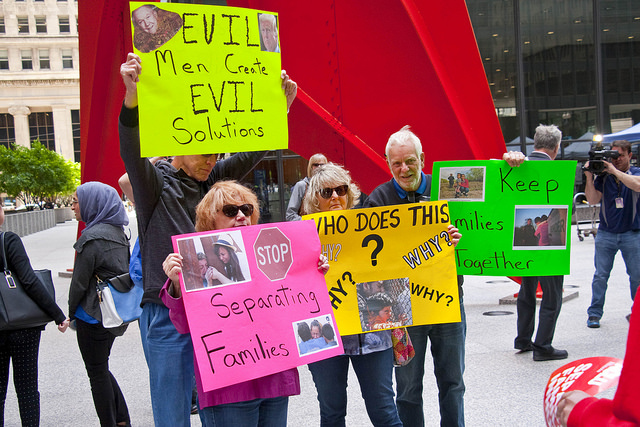US vs. Them: A Hidden History of Detainment Camps and Alterity in the US
 https://www.flickr.com/photos/cemillerphotography/28758035048/in/photolist-KPfrUu-CvnNsR-We6jY5-28zHfDb-R9Hthy-28JKn3p-RRu5kn-cpmbcN-azF1Rx-9fWMfn-fe2bZR-WboAeY-eoCxF-BxZh34-25UFoVs-DdbKWU-VSyhoU-QrQacm-XgKD6i-28JKoYt-27F21Lr-RNYkkW-S3xYVe-F2TSYr-FctBhA-SuNdJ7-FcEkpv-25crmdo-JifDPD-KPfthu-JifCyx-ypMhWc-JifDrK-KPfttb-25crkKu-LAXZHN-JifCVp-KPfsp7-28JKm6V-27DfsPJ-LAY1aQ-yHHXst-27mQQ8v-K5MVaX-LAY2fq-KPftmN-25YJVc5-27mQLXx-K5MVsa-JifCHa/
https://www.flickr.com/photos/cemillerphotography/28758035048/in/photolist-KPfrUu-CvnNsR-We6jY5-28zHfDb-R9Hthy-28JKn3p-RRu5kn-cpmbcN-azF1Rx-9fWMfn-fe2bZR-WboAeY-eoCxF-BxZh34-25UFoVs-DdbKWU-VSyhoU-QrQacm-XgKD6i-28JKoYt-27F21Lr-RNYkkW-S3xYVe-F2TSYr-FctBhA-SuNdJ7-FcEkpv-25crmdo-JifDPD-KPfthu-JifCyx-ypMhWc-JifDrK-KPfttb-25crkKu-LAXZHN-JifCVp-KPfsp7-28JKm6V-27DfsPJ-LAY1aQ-yHHXst-27mQQ8v-K5MVaX-LAY2fq-KPftmN-25YJVc5-27mQLXx-K5MVsa-JifCHa/
The United States has found itself in a state of shock and horror over the Trump administration’s recent immigration policies. Within this, the greatest source of outrage has arisen in response to the separation of families and the subsequent placement of young, vulnerable children in detention centers at the nation’s southern border. While this policy is not necessarily new – the Obama administration implemented a similar policy in 2014 following the mass influx of unaccompanied minors from Central America – the current situation certainly stands out to most citizens. Images show young children, the majority falling below the age of ten, being physically torn away from their parents only to be crowded into metal cages with barely enough room to sit. It seems to be the confused gazes of these innocent children that has captured the nation’s attention, with an outpouring of comments concerning their lack of culpability in the situation. Consequently, many advocates have argued that children should not be detained but instead placed with foster families while they await their unlikely trial in an already saturated extrajudicial system. The foster care solution, however, reveals another shortcoming of the US’ immigration policies: many of the individuals willing to take on these children are undocumented and thus risk their own deportation.

In time, the physical trauma of this experience will fade, but the emotional trauma and the intensity of these experiences will endure a lifetime. One of the most recent headlines from the New York Times pictured a young girl of two years old sitting alone in a courtroom, barely tall enough to see over the table- let alone stand trial. Clinging to her Dora doll, she sat in front of the judge wide-eyed and scared, unable to understand the judge, despite the judge speaking Spanish. To say these images are cruel and inhumane seems inadequate. In the wake of Trump’s policies that seek to isolate the US on all fronts, the US has become a paradoxically hostile respite for desperate migrants, especially those below the age eighteen. Despite Trump’s deterrent policies and this foreboding environment, migration rates from Central America have not fallen, which ultimately highlights the severity of the region’s conflict. Unfortunately, this new protectionist attitude has made it even more unlikely that these individuals will receive asylum, let alone the opportunity to even state their case.
How did it come to this?
The greatest irony of this situation is that the GOP, the supposed champion of family values, is the group responsible for the separation of these families. To many, these policies contradict a fundamental sense of justice that defines the US, and the use of these detention centres stands in stark antithesis to these US values.
Importantly for this situation, imprisonment and detainment are understood as fundamentally different. Imprisonment, which occurs in the domestic sphere, implies the presence of criminal activity and thus falls within the parameters of the US judicial system. In the case of migrants, they are considered foreign aliens, or non-citizens, who fall outside domestic law. This ultimately means that these individuals are neither guaranteed nor afforded the same right to due process and protection that a prisoner is. Instead, they fall outside of US law, entering into the territory of extrajudicial proceedings.
However, despite consistently identifying these individuals as foreign migrants to justify these harsh policies, US discourse, at both the individual and collective level, continually places these individuals within these domestic conceptions. In particular, despite the lack of a trial, they are frequently labeled as guilty criminals. Such notions are inherently contradictory, and if as a reader you find yourself confused by the previous sentence, you are not alone. The understanding of this migrant status, specifically those from Central America, is inconsistent to say the least.
Guilty before charged
US immigration policy has ultimately become a moral debate concerning the discourse of innocence and justice. They claim that their determinations of refugees and migrants are aligned with international standards, but this discourse has ultimately allowed the US to (re)formulate the definition in practice. If anything, their definitions are highly discriminatory and seem to be a question of race as opposed to security.
An analysis of the various news articles and headlines reveals a fundamental difference in how child migrants versus their parents, as well as adults more generally, are perceived, despite emerging from identical circumstances. Children are never portrayed as criminals but instead as ‘innocent victims’ who have become casualties of their parent’s ‘criminal’ decisions – while the parents are deemed ‘guilty’ foreign trespassers because of their very presence on US soil. Logically, one would ask what these individuals are actually guilty of, since they fall outside the domestic system of criminality, meaning it seems that other factors – such as citizenship or race – are used to determine and distort the notion of criminality and ultimately justify current immigration policies.
The ‘American’ Way
Returning to the question of ‘American’ values, detention centers may be more in line with these values than many citizens would like to believe. The US has a long – but decisively hidden – history of using detention centers to detain foreign threats, most of whom, ironically, were citizens themselves. While the US government refers to these facilities as refugee or migrant detention centers, many have compared these centers to concentration camps, which immediately invokes gruesome images of the Nazi Final Solution and the massive genocide that these camps facilitated. Individuals, such as Jeff Sessions who laughed at such a comparison on national television, will be quick to point out that these camps are nothing like those of the Nazi concentration camps since those were meant to prevent people from leaving. Historian Andrea Pitzer, whose research traces the rise of concentration camps, however, notes that detention centers, which appeared more than 40 years before Hitler rose to power, were historically imagined as a humane way to enact extrajudicial detention in circumstances where the national legal system did not have jurisdiction. In other words, these camps were used when ‘prisoners’ fell outside the realm of traditional legal proceedings, alluding to an inherent sense of alterity, or otherness, in relation to their captors. These individuals, who were detained for their difference, thus required a distinct system from which came the extrajudicial detention we see still implemented today.
Some of the first examples of these extrajudicial spaces can be traced back to U.S., with policies like Indigenous reserves or prisoner of war camps during the Civil War. Two of the most famous examples, however, are the Japanese internment camps of 1941, and the 1921 Tulsa, Oklahoma race riots. During World War II, the US government interned over 120,000 individuals of Japanese origin, 77, 000 of whom were US citizens. Years before that, in 1921, police detained over 6,000 African American citizens for their ‘own safety’ following a rape allegation against an African American teenager. While the violence of these riots lasted for about 24 hours, these citizens were forced to remain in these detention camps in the months following due to heightened racial tensions that led many local leaders to fear further conflict.
Concentration camps have also been used globally in times of conflict when nations were fighting in foreign territories and could not- and quite frankly did not wish to- use traditional judicial channels to prosecute their prisoners. The contemporary conception is derived from the Cuban War of Independence when the Spanish placed rebels in ‘reconcentración’ or ‘reconcentration’ centres to detain them. This policy was later implemented by the British during the Boer Wars in South Africa, by the Russians during and after World War II and countless Latin American dictators during the latter half of the twentieth century. The most famous current example of such a policy is Australia’s Pacific Solution, which transfers asylum seekers to detention centers on surrounding Pacific islands. These violent manifestations of these policies demonstrates the slippery slope when used at the institutional level, as they set precedents for defining and addressing alterity.
Us vs. them
In these circumstances, alterity, or ‘otherness’, is defined as anyone who deviates from an imposed standard, which is directly related to the group or individual in power. In the current case in the US, this status is a question of citizenship, as the migrants in these camps are non-citizens; yet, one cannot ignore the racial undertones. This notion of citizenship arguably provides a convenient cover up for questions of race. In other cases, such as in Tulsa or the internment of Japanese citizens, individuals are detained based on religion, race, and ethnicity, which are the traditional forms of difference that are used to justify these camps. In any case, these camps, at the most basic level, are rooted in the desire to isolate and in some cases, cleanse, alien individuals, and difference more broadly, from domestic soil. This institutionalization of alterity ultimately becomes a means of placing these individuals outside the traditional system and thus a justification for what would normally considered unjust and illegal treatment.
In these situations, executive orders are often enacted to create such policies, justified as a necessary suspension of democracy due to the sensitive and urgent nature of the situation. While there is no doubt that the influx of migrants in both 2014 and now is a timely issue, the decision to intern and criminalize refugee claimants seeking asylum seems not only antidemocratic, but also universally accepted as unjust, as international law affords migrants and refugees certain rights and protections. This concern is magnified by the fact that many of these individuals will never even make it to their hearing.
The ‘Immigration Question’
To concede a seemingly obvious point, immigration and the management of massive influxes of populations is a difficult and multifaceted issue. The current system is at 90% capacity and is already struggling. Children are being shuffled around and relocated from foster homes, to military style camps that some conservatives have compared to ‘summer camps’. These relocations have been cited as an unfortunate necessity to make room for incoming migrants that, despite the Trump administration’s attempts to deter, have not slowed. The reality of the situation is that these camps, which are abject to say the least, are a better option than staying and waiting to die in areas of intense conflict.
More broadly, the use of these camps in the US points to the tangible conceptions of alterity – in this case, borders become the divider: arbitrary yet rigid divisions deeply affecting the lives of those on the wrong side. Trump’s rhetoric of the ‘bad hombres’ smuggling drugs or the menacing threat of illegal immigrants stealing jobs demonstrates this clearly. There is a mythological component that manipulates this notion of alterity to give borders their charge.
On the question of migration, the charge becomes moralistic, inciting ideas of right and wrong tied to the border. The US government ultimately relies on this understanding of borders to justify their actions. By enclosing these othered groups in a defined space, these camps become places of exception that allow for different standards. This idea of different standards is extremely dangerous because it sets a problematic precedent. Migrant deaths are not random nor accidental, but come from the categorization of these individuals. These camps ultimately perpetuate alterity and with it, provide justification for distinct treatment that would not be acceptable in any other circumstance. The very premise of this alterity presupposes that migrants, their movements and international conflicts exist separately from the affairs of the U.S. or any other receiving country. These refugees are seen as outlaws living in liminal zones outside of society, which is inherently domestic. The truth is, the connections are much more intricate. These individuals and the issues they face are directly connected to U.S. affairs and its citizens, and the US needs to start realizing that.
Edited by Zoë Wilkins
